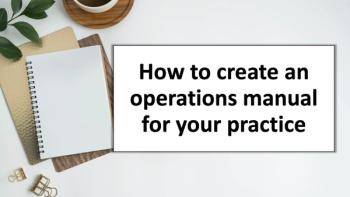
Managing Staff: Making the Most of Clinical Assistants
Midlevel providers can be a god-send to a busy practice, but you need to know how to best integrate them into your workflow.
CardioVascular Associates in Birmingham, Ala., has nine nurse practitioners. The practice’s administrator, Bill Cockrell, says he’s learned the hard way how to make nonphysician providers a positive addition to a medical practice.
His best advice? “To be successful, you need to have a plan on how you’ll use them,” says Cockrell. You can’t just hope hiring a nurse practitioner (NP), physician assistant (PA), or other nonphysician clinical staff member will automatically improve patient access and send revenue through the roof. Success takes planning.
Here’s what to do if you’re thinking about branching out.
Define your provider’s scope of practice
All allied health professionals are bound by the scope of practice of their position as defined by the state in which they practice. “The most important thing is that state practice act; every state has rules for supervision, delegation, and prescribing role[s],” says Bruce Armon, a partner in the Philadelphia-based law firm Saul Ewing and chair of the Regulatory, Privacy, and Healthcare Contracting Practice Group. To learn your state’s rules, the following sites will help:
- For links to boards of nursing, which usually define the scope of practice for NPs, visit
www.ncsbn.org/regulation/boardsofnursing_boards_of_nursing_board.asp .
- For a summary of state regulations for PAs, visit
www.aapa.org/gandp/statereg.html . Or you can call your state medical society or an experienced local lawyer.
That sounds easy enough, but state rules aren’t always written clearly, and things can get really confusing if you practice in states with particularly obtuse guidelines.
A case in point: A 2005 article in Topics in Advanced Practice Nursing eJournal reads:
“NPs in Oregon can independently prescribe Schedule II-V narcotic medications with their own DEA number and without a collaborative agreement. Between August 2001 and July 2005, NPs could prescribe Schedule II-IV drugs in Washington only if they had a mandatory joint practice agreement (JPA) with a physician. … A law passed in 2005 eliminated the JPA requirement and allows Washington NPs to prescribe all controlled substances independently as of July 24, 2005.”
So you need to stay on your toes when it comes to defining your clinical staff’s scope of practice.
That said, the risk that you will be reported for any infringement in this arena is pretty limited. According to the Nurses Service Organization’s 2004 claims data, operating beyond one’s scope of practice accounted for just 6 percent of all claims filed that year. When it comes to defining scope of practice, the big issue appears to be under-using allied health professionals rather than over-using them.
Cockrell says the biggest problem with the NPs his practice employs is that physicians don’t use them enough. Sometimes surgeons will just ask them to take dictation. Others may ask an NP to do an initial history and physical on a patient, only to repeat the same processes themselves. “It’s a waste of resources,” says Cockrell. “You are wasting the premium you are paying for an NP.”
Cockrell encourages physicians to adopt a more cooperative work relationship with their clinical team, by having NPs handle follow-up visits alone, for example. “The physician working in a team with the NP, that is what makes the difference,” he says. “If you aren’t going to do that, you might as well hire a physician.”
Physicians should take the lead in defining which roles an NP or PA will play in their practice, making sure their clinical assistants are comfortable with their roles. “Just because the law might allow it … doesn’t mean the practice needs to do it,” Armon points out. Be able to articulate what the allied health professional’s job will be in your practice during the interview stage to ensure you hire someone prepared to perform the tasks you expect. Also, plan to revisit your new hire’s scope of practice after six months. You may feel more confident in his abilities than you did initially, and subsequently you may want to add to his patient care role.
Avoid billing bungles
Before beginning the hiring process for clinical staff, you should also be absolutely clear about how you intend to bill for the services an NP or PA will provide.
There are two basic ways such providers can bill: “incident-to” at 100 percent of the physician fee schedule or under their own provider numbers at 85 percent of the fee schedule.
If you anticipate billing incident-to, here’s a quick primer on the rules:
- “Incident-to” means the care is being provided incident to care previously delivered by a physician. The provider is following a course of treatment you’ve already set in motion.
- You or another supervising physician need to be in “the office suite” when your clinical support staff sees patients. That does not mean being available by phone at the hospital or your suburban office.
- Incident-to is an outpatient-only concept. You cannot bill this way for hospital services.
- Incident-to is a Medicare-only concept. You can’t assume commercial managed-care plans will allow you to follow the same rules or even allow incident-to billing at all. “Many managed-care plans do not recognize midlevels as providers but do allow them to work under the physician contract,” says Alice Gosfield, a Philadelphia-based healthcare attorney. “Evaluate carefully how you will use the midlevel for those contracts in contrast with Medicare.” The only way to know your payers’ rules is to read their guidelines or give them a call.
- Even if you bill incident-to, allied health professionals need to be credentialed with payers through the practice. Allow time to complete this process before any new hire’s start date.
If you prefer that the provider bill directly for her services, she needs a unique UPIN (and now a national provider identifier, too), says Gosfield. Either way, she says, “be very clear about the level of visits the midlevel will bill. Although there is nothing that prohibits it, midlevels billing [Level] 5s and high volumes of [Level] 4s would likely draw attention, since that is not typical and could trigger an audit. I have one practice right now where the PAs billed on their own numbers; they are undergoing a probe audit. When a consultant reviewed the billing, it was 95 percent wrong.”
Make sure any nonphysician providers you hire know how to code if you decide to go that route. Then review their work periodically to ensure their coding and documentation are accurate and that they are practicing within the scope and quality guidelines you’ve established.
Balance your budget
Once you have established which specific tasks your allied health professional will perform and how you will bill for them, you’ll be better equipped to know whether you can afford to hire such staff and how much you can pay. Here’s how:
Develop an estimate of how much money a potential PA or NP in your practice could generate by multiplying the number of patients an average provider in your practice sees per day (generally, 12 to 20) by the reimbursement you expect to receive from such visits. Don’t make this calculation using 20 patient visits per day unless you’ve determined that 20 patients could use the new hire’s services each day within the scope of care you’ve defined.
Then estimate the expenses your new staff member will incur. According to the Medical Group Management Association (MGMA), the median salary for an NP in 2004 was $70,326 in nonsurgical practices and $79,851 in surgical practices. The median for PAs in primary care was $74,447 in nonsurgical practices and $73,426 in nonprimary care practices.
Your PA or NP will most likely require some clinical support and, of course, front-office and billing support as well. Make sure you factor these needs into your expenses too.
Subtract these expenses from the estimated revenue the new staff member would produce, and determine whether it is cost effective to hire her. According to MGMA data, most NPs and PAs bring in more than enough revenue to cover their salaries. The association states that in 2004 nurse practitioners brought in $172,579 in median collections for professional charges. Not a bad return on a $70,325 investment.
Even if your numbers don’t look great, some physicians, such as surgeons, choose to support an NP or PA financially (that is, they lose money on them) for quality-of-life reasons - their nonphysician providers don’t make them money, but they do save them time. Or a surgeon may decide to employ an NP or PA to give her more time in the operating room. So even if she is losing money by paying the provider’s salary, she more than makes up for it with additional surgical revenue.
Hire right
If you decide to proceed with hiring an NP or PA, create a formal employment agreement that builds in accountability. “Use a contract that is similar to a physician employment contract,” suggests Gosfield. “Depending on your state, you may want to have restrictive covenants as well.”
Armon calls contracts “a good start.” One of his clients had employed a PA who was moonlighting. The physician said he could offer the PA additional hours if she came to him first. The PA ignored this and continued moonlighting. She was eventually dismissed.
Armon suggests including language in clinical assistant contracts that addresses the following issues: term and termination; non-solicitation; non-competition; salary; benefits; required compliance with rules and regulations; and credentialing requirements. Be open with your prospective hire about the role you want him to play, and ask what has and has not worked in his previous jobs regarding his relationships with physicians.
Offering a creative salary package may also help. Cockrell’s NPs receive a base salary for generating a basic amount of collections. If they exceed it, half of that extra cash goes into a pool that is shared equally among all the NPs who meet a specified productivity goal. That motivates the NPs and has also encouraged them to be more assertive with physicians who underutilize them, reports Cockrell. “They put pressure on physicians if they see a benefit,” he says.
Make introductions
Once a clinical assistant settles into your office, take time to introduce him to your patients. Don’t position him as a back-up or second-best provider when you are unavailable. Introduce him as your second arm. Front-desk staff and schedulers should also understand the NP’s or PA’s role. Tell them what services your new hire can provide. You want the right patients referred to him.
Cockrell thinks his practice’s patients are very accepting of his NPs. “They want to see their physician, but the NPs are really focused on those patients.” he says.
NPs, PAs, and other nonphysician clinical providers can be a real benefit to practices of all kinds - if they are used wisely.
Pamela L. Moore, PhD, is senior editor, practice management, at Physicians Practice. She can be reached at
This article originally appeared in the September 2006 issue of Physicians Practice.
Newsletter
Optimize your practice with the Physicians Practice newsletter, offering management pearls, leadership tips, and business strategies tailored for practice administrators and physicians of any specialty.








